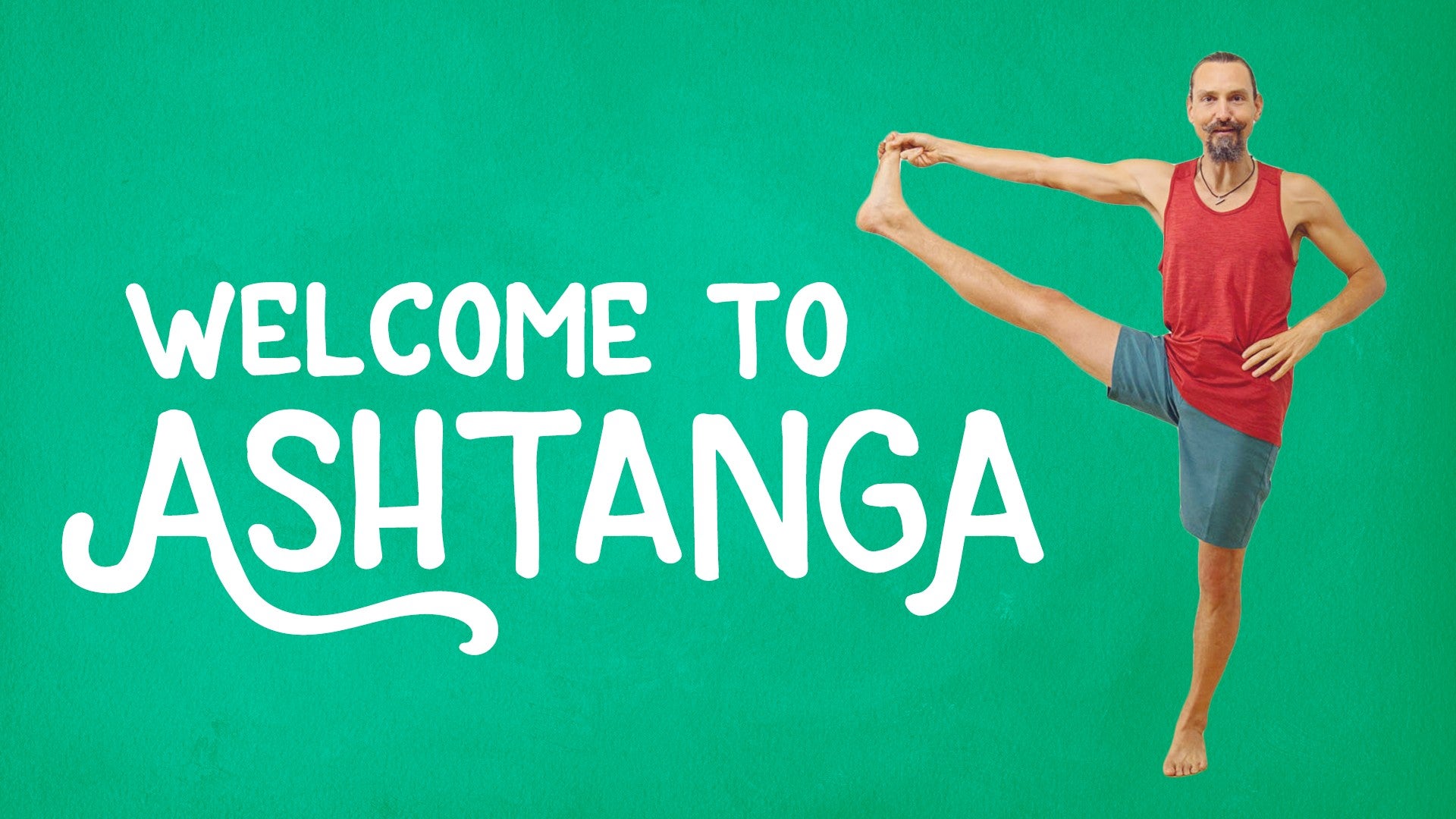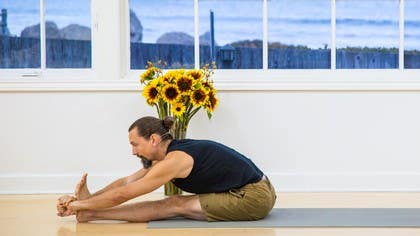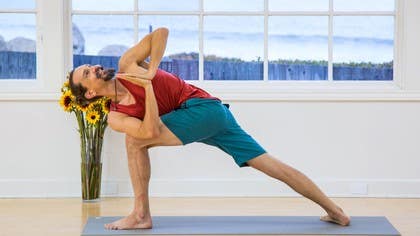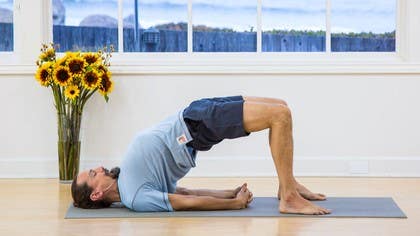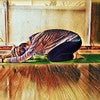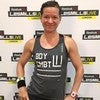Description
About This Video
Transcript
Read Full Transcript
Welcome to the great adventure that is the seated vinyasa practice. These days a lot of times people associate yoga with individual postures but we know yoga is a much bigger picture than that. This realization is readily available to you when you practice our stranga because we value the transition between postures just as much as we value any individual pose. So as we take a look here at seated vinyasas please remember that following your breath, doing that looking inside, looking for bandhas and watching your own process is more important than achieving any particular fancy jump back or any particular posture. But it'll be a very interesting journey for us to refine, one that you'll keep coming back to day in and day out as you practice primary series. Once you've finished the standing sequence then you go into seated series and all the postures are linked together by this seated vinyasa practice which is like a sun salutation A just cut down into a very short form. So the seated series begins in dandasana, the stick pose. You can join me at the top of your mat, sitting with your legs extended, knees straight, the kneecap still lifting towards the pelvis so the legs remain strong even in your seated postures. The hands just next to your hips, don't worry if your hands don't comfortably touch the mat completely, they may be floating or you may be on your fingertips. If you could ground the palms to the floor feel free and roll the shoulders back and down keeping the bandhas engaging so that the breath lifts up the chest and keeping the tailbone in a neutral position. So you find here you're basically in samastitihi except with a 90 degree bend at your hips. So this will be the neutral pose of the seated practice. You can take five breaths here dropping the chin a bit and looking down the tip of the nose and nasa gradrishti. So you remember that the priority is on internal awareness, hearing the sound of your long deep, full smooth breathing. And then the seated series begins with two forward bends, two forward folds, very similar to the way that the standing series begins. Arshta, inhale, reach forward and grab your big toes. Keep the big toe mound pushing forward just as if you were standing on the mat. So keep the feet flat as if they were on the floor, avoid the tendency to let the pinkies wrap forward. Inhaling there's a long straightening of the spine and a nama. Exhale folding forward just as you do in standing, bending the elbows a little but keeping the shoulders rolled back and down and your drishti will go towards the big toe. So you're looking towards the big toe as you breathe. One, if you've gone down very very deeply in the posture it may be difficult to see the big toe. Two, that's okay you just keep the eyes reaching that way. Three, if you're not down so deeply in the posture it's very easy to maintain that drishti.
Four, and take advantage of that by letting the eyes rest on the big toes. Five, dasya, inhale, straight arms, straight spine as you exit the posture lengthening the upper back. And exhale, take your hands around the feet. You could wrap the hands around to take the wrist or you could take the outside of the feet or just reach the hands over the feet whatever feels right for parashimattanasana B. And then again, nava, inhale lengthening and exhale fold forward into the pose letting the eyes remain on the big toes. One, all the while remembering every exhalation the Bandhas become more and more easy to find. Two, as you exhale completely feeling that lift internally. Three, four, still rolling the shoulders away from the ears. Five, dasya, inhale, just lengthen the spine but maintain the connection of the hands and feet. You could even pull the chest forward a little rolling the shoulders back. And then exhaling, break the drishti. You can cross the legs and plant the hands down. And now just watch. We'll demonstrate a very modified vinyasa approach and then we'll do one very modified together and you'll have plenty of time to be able to practice more deep approaches as we go forward. But for now exhaling completely I'll put the hands down and then inhaling I'll lift the spine. So finding that lift even if it's just internally lengthening even with the hips and feet on the mat. And then exhaling, tucking the feet under, putting the hands at the front of the mat, stepping the feet back and lowering down to a very deeply modified chaturanga so that you're all the way down the mat, the collarbones are open. Your next inhalation draws to a modified up dog like a baby cobra, chest forward, shoulders back. And then exhaling your way to a modified downward facing dog lifting the hips to the back corner of the room. You could keep the knees bent so you find that length through the spine. Inhaling, stepping the feet forward and come to a seated posture. Lowering the hips and then straightening the legs right back to where you started in dandasana, that neutral pose of seated. So let's try one together. Very very modified, use restraint and just try to follow your breath. From paÅ?imÄ쳌tarÄ쳌á¹£á¹?abhi, inhaling the length through the spine, exhaling letting the go of the feet, breaking the drishti, putting the hands down. Inhale simply lengthen, internally lifting. Exhale, tuck the feet under, hands down, step back to any chaturanga modification all the way down. Inhale, chest forward through the shoulders, rolling back and down. Exhale, tucking the toes under, lifting the hips in a downward dog modification. And inhale, step the feet forward, cross the legs, sit the pelvis on the mat and then straighten the legs in front. And voila, you're back to dandasana, hopefully following your breath. So other postures occur, everyone will follow a very similar jump back and jump forward transition. We'll skip the next few poses and just look at JanuÅ?rá¹£asana A because it's really easy to approach. So from the right side, exhaling, putting your right foot back, like tree position, the sole of the foot, flat on the left thigh, the knee out to about 90 degrees. Inhale, again reach forward, take the foot or take the leg if you can't take, if you're not able to take the foot, lengthen the spine, let the drishti catch the big toe and then ashta, exhale, folding forward, looking towards the big toe and breathing here. One, again if you've gone deep into the posture, just let the eyes journey forward. Two, you're looking on to your left big toe. Three, keeping the spine lengthening, the breath lengthening. Four, finding that stability which is available to you in asana. Five and nava, inhaling, a long spine, straight arm still gazing on the toe. Your next exhale, you break the bind of the hands, you can leave the drishti, cross the legs and plant the hands down. So now I'll demonstrate a more refined and more deep approach to vinyasa. Just take a look, watch me and then we'll do one together again. Exhaling, so important here that you complete the full exhale. Push extra breath out and that should again allow you access to udiyana bandha, mula bandha, very deeply grounding internally, spreading the fingers wide on the mat, planting the hands so that your next inhale, instead of just lengthening through the spine only, lengthens the spine and also hopefully gives you the ability to lift your hips up off the mat. As well as you deepen, develop and strengthen, you'll be able to lift one or even both feet, squeezing to the little ball as you lift up off the mat and your next exhale may find you shooting the legs back all the way to your old friend chaturanga dandasana. Inhaling to upward facing dog, exhaling to downward facing dog. Now that's all good and fine if you can lift your pelvis up off the mat, if you can lift your feet off the mat as well. But again don't get caught up on that as some sort of simple success or failure in yoga. Yoga is about much more than being able to accomplish any physical activity. So instead follow your process. Exhale, cross the legs completely. When you inhale and lift, maybe you can only get the hips up. That's fine. Then you can go back to the other vinyasa technique of exhaling, rolling forward and stepping or hopping back to any modified chaturanga. Or as you develop and deepen your practice, your exhale may again find the bandha really engaging and your inhale you may lift the pelvis and lift one foot up so that you're engaging the core or lift both feet up and exhaling try to scoot the legs back.
They may not make it. You may have to do some adjustments, some shuffling, some walking and that's fine. Just so that you find your way to that chaturanga at the end of the exhale. The next inhale draws the chest forward through the shoulders rolling back and down, exhaling your way to downward facing dog. To jump through, inhale and I'll give you the time to take a few practice hops when we do it together. You'll cross the legs as you jump and see if you can again find that little ball squeezing and lifting off the mat. Exhaling and down dog, inhaling the hips coming forward above the shoulders, the feet crossing and squeezing the feet up away from the mat. You may be able to find your way right back into dandasana. Again if that comes easily, wonderful. If it doesn't, also wonderful, just keep following your breath. Your inhale may find you lifting, you may find the feet on the mat, you may even crash down on your bum, that's fine. Finish the inhale finding your way into dandasana. Alright so now that you've seen and heard about it, let's have you try one together with me. Exhaling, cross the legs, plant the hands. Don't forget to exhale completely, push the breath out. With the inhale, lengthen the spine, push down through the arms and try to lift up off the mat. With your exhale, either shoot the legs back or step, but find your way to any chaturanga that serves you. Inhale, the chest forward, the shoulders rolling back and down and upward facing dog. Exhale to downward facing dog. Now we'll take a few practice hops together. As you inhale, bring the hips above the shoulders and exhale just come back down. So take a few with me. Inhaling, hips up, exhaling, coming down. Try to keep the legs more or less straight, you don't need to bend them particularly a lot. And then we'll cross the legs and jump through. Inhale, hips up, cross your legs, squeeze the feet away from the mat and come to seated. Now to come through gracefully, smoothly and make it look effortless is actually quite hard. But don't worry, you've got plenty of time to practice it. Most important thing is that you're following your breath as you go through this sequence. Finally, we're on the left side then. Exhaling, draw your left foot back. Inhale, reach forward, lengthen the spine, looking towards your right big toe and exhale folding forward. Taking full deep breaths here, remembering the priority of this yoga practice. Two is not about achieving any posture or achieving any special transition. Three, it's really about following your breath and looking inside. Four, five. Inhaling, lift and lengthen. The head comes up, the spine is long, the arms are straight. Exhale, break the drishti and we'll just go together on a pace. Cross the legs, plant the hands. Inhale, lift, exhale, step or jump back, lower down any chaturanga.
Inhale, upward-facing dog. Exhale, downward-facing dog. And inhale, hop or step or jump to get yourself back to dandasana, finishing the inhale there. Then exhale. Great. So hopefully these techniques will be of service to you as you keep practicing our sthanga. Every day going through, some days you'll feel wow I'm really lifting, some days you'll feel like today I need to modify. I really encourage you to listen to that and take your time and honor your practice knowing that through daily practice the more subtle benefits of yoga will be revealed to you and I wish you all the best success and blessings on your path.
Welcome to Ashtanga
Comments
You need to be a subscriber to post a comment.
Please Log In or Create an Account to start your free trial.
